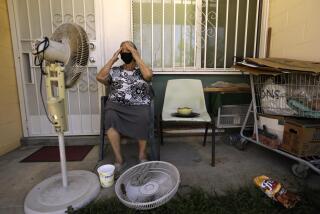Home Improvement : ‘Tis the Season to Fix Heat Loss Problems
- Share via
With cooler weather on the way, now is the time to make sure your home is energy efficient to cut down on your heating bills. An energy audit, covering dozens of areas, helps spot heat loss problems that can push utility costs through the roof.
Exterior doors must be maintained much like windows to guard against air infiltration. Look for gaps around the door on sides, top and bottom. Gaps under the door can be sealed by installing a door sweep. Other gaps can be sealed by weather stripping.
Storm doors are expensive and may not be economical. A less expensive alternative is to install a glass or acrylic panel over the glazed area of the door during winter.
A final observation our energy auditor made on the exterior was to point out patched wall areas, which indicate blown-in insulation. If there were no visual clues, we would check for wall insulation from the inside of the house.
The next part of the audit took place in the attic, where we checked for insulation in the floor. You should spot check the entire attic for insulation, as some homes have only partial coverage. A rule to follow when you determine what areas should be insulated: All heated areas of the house should be separated from unheated areas by insulation.
Insulation prevents the flow of heat out of or into the house. It is specified by R-value. The R stands for resistance to heat flow. The higher the R-value, the greater the insulating ability.
Since heated air rises, the attic is the most cost-effective area to insulate in a home. In an attic with an unfinished floor, insulating involves placing batts parallel between the floor joists.
If the insulation reaches the top of the joist, and more is desired, installing batts perpendicular to those already in position and over the joists reduces heat loss through the joist. A thorough installation without compressing the material and without leaving gaps is important.
If the floor is boarded over, you must remove some boards and use a stick to push batt insulation under the flooring. Or a contractor must blow-in insulation under the flooring.
Vapor barriers such as foil, plastic and impregnated kraft paper will impede the flow of moisture, and will prevent or minimize condensation problems. The vapor barrier should face the heated area of the house, separated from moisture leaving the house.
When you insulate an attic, it’s important to provide adequate ventilation. Without it, moist, cold winter air may condense and introduce moisture problems.
Vents should be provided by at least two vent openings, located so that air can flow in one vent and out the other.
More to Read
Sign up for Essential California
The most important California stories and recommendations in your inbox every morning.
You may occasionally receive promotional content from the Los Angeles Times.






